You can get quality instruments at affordable prices. In fact, some nice gems are hidden in the lower-priced tiers. We have searched high and low to come up with this shortlist of the best acoustic guitars under $300. Read on to see our top picks.
(Concert Size)
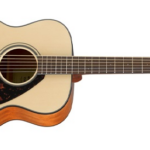
Yamaha FS800
If you need more emphasis on the mids and high frequencies, the Yamaha FS800 is the wallet friendly guitar to get.
(Dreadnought Size)
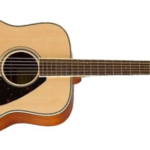
Yamaha FG820
Dubbed "the poor man's Martin", with the same warmth for a fraction of the price. Mid-focused sound with mild highs.
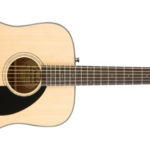
Fender CD-60S
An affordable yet quality instrument, with good tone and playability. Ideal for playing on your couch or outdoors.
(Mahogany Body)
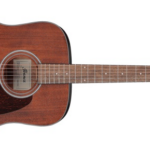
Ibanez AW54
A cheap guitar with a nice “warm” tone and strong mids. Great for folk, blues, country music, and other finger-style songs.
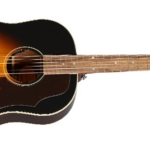
Epiphone J-45
The Epiphone J-45 is a true workhorse guitar that captures the essence of the original Gibson J-45 at a cheaper price.
We’re reader-supported. When you click product links on our site, we may earn an affiliate commission at no extra cost to you.
To come up with our best cheap acoustic guitar recommendations, we’ve taken into consideration important factors like build quality, tone, playability, and value for money. We also utilized Gearank‘s updated ratings, which reflect current market sentiment.
If you’re curious, you can see the current ratings for each of these good acoustic guitars under $300 on Gearank.com.
In addition to our recommendations, we’ve also provided practical tips on What to Look for in a Sub $300 Acoustic Guitar.
Note that only traditional acoustics with no pickups or electronics are featured here. If you’re looking for the top acoustic electric guitars, you can find them elsewhere in Gutiarsite.
If there’s a guitar you think we’ve missed, please let us know in the comments below. You can also get further advice from our guide to The Best Acoustic Guitar Brands, or if you’re looking for less expensive options, take a look at our guide to The Best Cheap Acoustic Guitars Under $200.
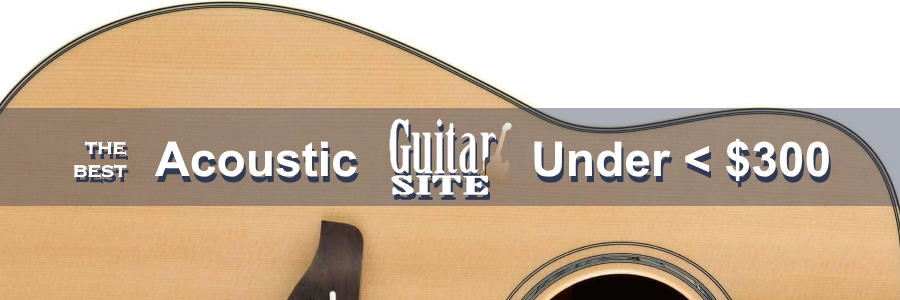
Detailed Descriptions of the Best Acoustic Guitars Under $300
Best Concert Size
Acoustic Guitar Under 300
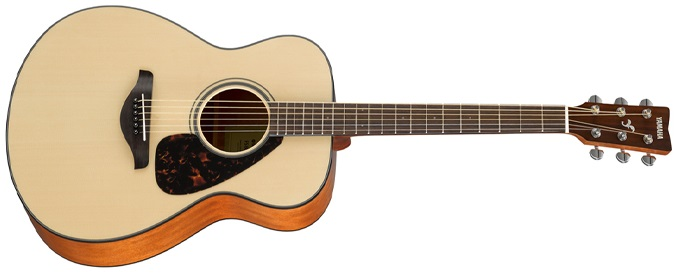
Yamaha FS800
Guitarsite Expert Opinion
A more compact version of the FG800, the Yamaha FS800 puts more emphasis on the mids and highs. And it has a student friendly feel, including the shape of the guitar.
Manufacturer: Yamaha FS800
We’re reader-supported. When you click product links on our site, we may earn an affiliate commission at no extra cost to you.
When looking for an acoustic guitar that is worth the cost, you usually gauge guitars under 300 in terms of price. But what really makes one the best acoustic guitar for the money is the value that you’re getting. This means having good playability, sound, and overall build.
The FS series from Yamaha ensures that you get the best affordable acoustic guitars in this price range, including playing experience and sound quality.
With its concert body shape and shorter scale length, playing most songs will be a breeze. But it has a more mid-trebly sound due to its smaller frame.
And even though it’s slightly small, the FS800 still packs a punch. With Yamaha’s scalloped bracing and solid spruce top, this acoustic guitar can produce a rich and full sound that is perfect for strumming chords or fingerstyle playing.
The neck with the satin or matte finish is a crowd favorite. Matte finish is a preference by many as it helps avoid the sticky hands that you’ll usually experience with a gloss finish. With satin, you can go up and down the neck smoothly, which is great for playing fast-paced songs.
Thanks to its slightly narrow nut width, the FS800 is easier to grip. So, forming chords becomes easier. This is a big plus, especially if you’re a beginner, have smaller hands, or even if you just want a slim neck profile in general.
Yamaha naturally has to cut some corners, so don’t expect premium hardware and tonewood on this model.
Overall, the Yamaha FS800 is a good guitar to have for serious students and beginners – with a quality that even seasoned musicians will appreciate.
Pros:
- Great value solid spruce top guitar
- Good projection
- Warm tone with emphasis on mids and highs
- Beginner-friendly neck feel
Cons:
- Lacks low-end depth
Specifications: | |
|---|---|
Body Shape: OOO or Concert
| Top: Solid Sitka Spruce Top |
Back and Sides: Laminated Nato/Okoume/Eastern Mahogany
| Body Finish: Gloss |
Neck Finish: Matte or satin
| Bridge: Walnut |
Neck: Nato/Okoume/Eastern Mahogany
| Neck Profile: Standard |
Fingerboard: Walnut
| Fingerboard Radius: R400mm (15 3/4″) |
Number of Frets: 20 | Frets to Body: 14 |
Scale Length: 650mm (25 9/16”)
| Nut Width: 43mm (1 11/16”) |
Tuning Pegs: Die-cast Chrome(TM29T)
| Saddle: Urea/Plastic |
Nut: Urea/Plastic | |
Best Dreadnought
Acoustic Guitar Under 300
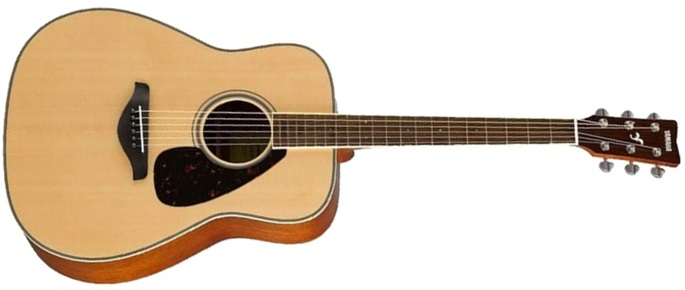
Yamaha FG820
Guitarsite Expert Opinion
A mid-focused sound with mild highs. The Yamaha FG820 is dubbed the poor man’s Martin, for it resembles the warmth of a Martin for a fraction of the price.
Manufacturer: Yamaha
We’re reader-supported. When you click product links on our site, we may earn an affiliate commission at no extra cost to you.
The Yamaha FG820 is just a step below the FS800 but is slightly more expensive than the latter.
For the back and sides, they use the same Okoume wood, which is like the Asian version of mahogany. Everything else is mostly the same, from its traditional dreadnought acoustic profile down to the small details of its build quality.
For its price, the FG820 gives you quite a lot, most noteworthy of which is its solid spruce top. And while the solid top guitar by itself is nice, it works even better when paired with good craftsmanship, as one would expect from Yamaha.
Dubbed as the “poor man’s Martin”, the FG820 has a similar robust tone. It has a lot of volume, which makes it a good guitar for strumming chords.
To allow the top to resonate better, Yamaha equipped their FG series with scalloped bracings, which provide better resonance without compromising structural integrity.
Again, Yamaha is able to make premium features more accessible for beginners to enjoy. The neck follows what Yamaha describes as a standard profile, which, looking at the specs, means that it simply follows the conventional dreadnought acoustic neck shape.
Value for money is the obvious strength of this guitar; it also helps that it comes with cream-colored bindings on the body and fingerboard, which prevents it from looking like another stripped-down cheap acoustic guitar.
Pros:
- More mid-range focus with mild highs
- Can really be loud, with lots of sustain, and projection.
- Very comfortable size and midsection for a dreadnought.
- It's satin finish on the neck allows for better playability.
Cons:
- Doesn't have the best bass
Specifications: | |
|---|---|
Body Shape: Dreadnought
| Top: Solid Sitka Spruce Top |
Back and Sides: Nato/Okoume/Eastern Mahogany
| Body Finish: Gloss |
Neck Finish: Matte or satin
| Bridge: Walnut |
Neck: Nato/Okoume/Eastern Mahogany
| Neck Profile: Standard |
Fingerboard: Walnut
| Fingerboard Radius: R400 mm (15.75″) |
Number of Frets: 20
| Frets to Body: 14 |
Scale Length: 647.7 mm (25.5″)
| Nut Width: 42.86 mm (1.6875″) |
Tuning Pegs: Die-cast Chrome(TM29T)
| Saddle: Urea/Plastic |
Nut: Urea/Plastic | |
Best Budget Friendly
Acoustic guitar under 300
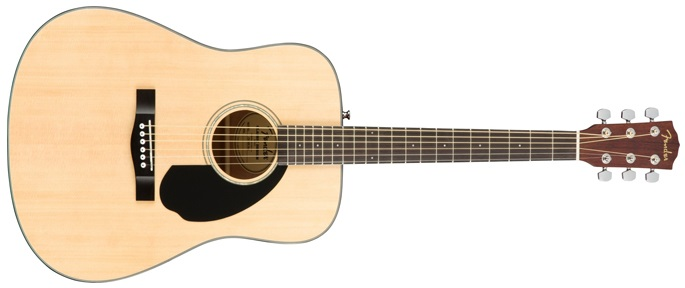
Fender CD-60S
Guitarsite Expert Opinion
One of Fender’s most popular models is ideal for players looking for an affordable yet quality instrument. With its great tone and playability, this guitar is perfect for playing on your couch, at the campfire, or even in a coffee shop.
Manufacturer: Fender
We’re reader-supported. When you click product links on our site, we may earn an affiliate commission at no extra cost to you.
Fender is no stranger when it comes to making guitars. Pioneering the first solid-body guitar and amplifier that revolutionized the way music is presented to an audience.
Their guitars are known for their high-build quality and exceptional craftsmanship. The Fender CD-60S is no different. Coming in at $200.00, as of this writing, this model is one of their best cheap guitars.
A classic dreadnought-shaped guitar, the CD-60S is built with quarter-sawn spruce and scalloped X bracing. This provides a solid foundation to support the solid spruce top and mahogany sides as well as the back, giving it more durability.
The combination of a solid spruce top and mahogany back and sides keeps production costs to a minimum. This pairing offers a good balance of warmth and a slightly more pronounced top end.
It has an all-solid wood construction for the back and sides. This means that the instrument will age better in comparison to others with laminated parts.
And you need not worry about getting heard; with its dreadnought acoustic body, this model has lots of volume. It’s great for strumming, with an emphasis on clarity in exchange for note articulation.
It has a 25.3″ scale length, which is a bit shorter than the regular 25.5″–26″ of most dreadnoughts. This reduces the strain on the strings by a bit which translates to a more relaxed playing experience.
To increase the playability even more, the CD-60S features their signature Fender ‘Easy-to-Play’ shape with rolled fretboard edges. A C-shape neck profile to facilitate smooth fretboard navigation and reduce fatigue from your finger even with extended playing
The gloss finish makes it look fancier; however, this can be a concern if you have sweaty hands. If you’re familiar with DIY, some players recommend a light buffing on the back just to take a bit of the top polish off.
The Fender CD-60S is a best-value acoustic guitar if you want a loud acoustic guitar for strumming, that has more brightness to it. It’s built with quality and provides an instrument that is meant to last and even improve over time.
Pros:
- Has a great dynamic range with a lot of focus on the mid-range
- Has lots of volume
- Great for hard strumming, fast flatpicking, or delicate fingerpicking.
- A comfortable neck
Cons:
- Lots of users complain about fret buzzing.
Specifications: | |
|---|---|
Body Shape: Dreadnought | Top: Solid Sitka Spruce Top |
Back and Sides: Solid Mahogany | Body Finish: Gloss |
Neck Finish: Gloss Urethane | Bridge: Walnut |
Neck: Mahogany
| Neck Profile: Fender® ‘Easy-to-Play’ shape with rolled fretboard edges
|
Fingerboard: Walnut/Rosewood | Fingerboard Radius: R305 mm (12″) |
Number of Frets: 20
| Frets to Body: 14
|
Scale Length: 643 mm (25.3″)
| Nut Width: 43 mm (1.69″)
|
Tuning Pegs: Chrome Die-Cast
| Saddle: Crème Plastic |
Nut: Crème Plastic | |
Best Mahogany Body
Acoustic Guitar Under 300
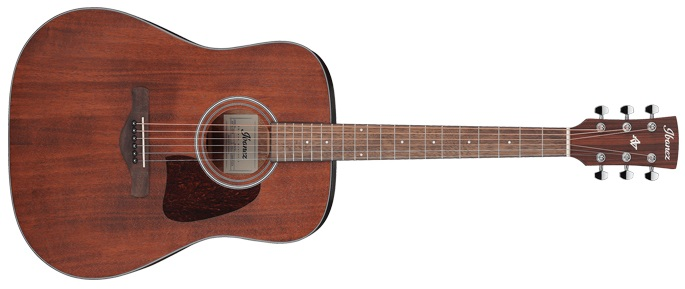
Ibanez AW54
Guitarsite Expert Opinion
This guitar has a “warm” tone, with a stronger representation of the mid frequencies. It’s great if you’re looking to play folk, blues, country music, and other finger-style songs.
Manufacturer: Ibanez
We’re reader-supported. When you click product links on our site, we may earn an affiliate commission at no extra cost to you.
Owning an acoustic guitar is like having a piece of furniture, they are mainly made up of wood.
And just as how quality furniture improves your living space, quality acoustic guitars like the Ibanez AW54 can improve your musical experience.
The AW54 is part of Ibanez’s ArtWood series. This dreadnought-type acoustic guitar has a solid Okoume top and laminated back and sides made from the same wood.
It sits atop a standard X brace for support. And though it’s not scalloped like the other guitars on this list, Ibanez explained that its open-pore finish allows this instrument to still breathe and resonate nicely.
A concern going forward, though, is that this type of finish is more susceptible to moisture and dirt. So, if you’re after the looks of this instrument alone, a guitar with a satin finish will have just the same look to it.
But if you’re here for the guitar’s sound, this guitar has a “warm” tone, with a stronger representation of the mid frequencies. This is kind of a sleeper model and one that has a warm vintage sound which is close to a high-end Martin.
Straight out of the factory, this guitar has a relatively low action. If you’re not into low action acoustics, this can easily be adjusted with a proper setup by a capable luthier.
The Ibanez AW54 isn’t as popular, but it’s among the best-beginner guitars for a reason. It’s a good quality instrument that you can buy for cheap.
Pros:
- Warm mid-focused tone with great projection
- Nice harmonic overtones
- Solid Okoume top
Cons:
- Chunky neck
- Prone to dings and scratches
Specifications: | |
|---|---|
Body Shape: Dreadnought body
| Top: Solid Okoume |
Top: Solid Okoume
| Back and Sides: Laminated Nato/Okoume/Eastern Mahogany
|
Body Finish: Open Pore
| Neck Finish: Open Pore
|
Bridge: Indian Laurel
| Neck: AW/Nyatoh
|
Fingerboard: Indian Laurel
| Fingerboard Radius: R400 mm (15.75″)
|
Number of Frets: 20
| Frets to Body: 14
|
Scale Length: 648mm (25.5″)
| Nut Width: 43mm (1.69″)
|
Tuning Pegs: Chrome Die-cast tuners (18:1 gear ratio)
| Saddle: IVOR X2 (Synthetic Plastic. Ibanez claimed to be more dense than bone)
|
Nut: IVOR X2 (Synthetic Plastic. Ibanez claimed to be more dense than bone)
| String Spacing: 11mm |
Epiphone J-45
Best Vintage Style
Acoustic Guitar Under 300
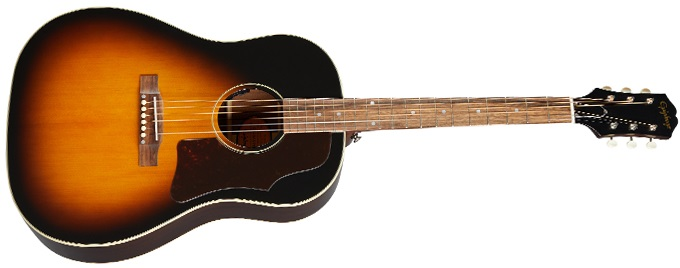
Epiphone J-45
Guitarsite Expert Opinion
The Epiphone J-45 recreates all the good features of the original Gibson J-45 (dubbed as “the workshorse”), with added modern flare. Same body shape and retro inspired aesthetics.
Manufacturer: Epiphone
We’re reader-supported. When you click product links on our site, we may earn an affiliate commission at no extra cost to you.
The Gibson J-45 guitar was played by some of the biggest names in music, like Bob Dylan, Buddy Holly, and Elvis Presley, among many others. So, you know, it’s an instrument built for a professional stage.
Thanks to Epihone’s “Inspired by Gibson” series, you can play something similar at a much cheaper price.
The Epiphone J-45 in particular is patterned from the original J-45, capturing the essence of the original Gibson guitar, minus the hefty price tag.
The Epiphone J-45 is a sloped-shoulder dreadnought acoustic. It is less bulky at the top, allowing better access to the neck, especially in the higher frets, in comparison to the traditional box-shaped dreadnoughts.
In general, this guitar has a well-rounded sound with a bit of a high-end that is perfect for both strumming and fingerpicking. A scalloped X bracing made of quarter-sawn spruce adds more structural integrity to the guitar.
The scalloped braces allow the instrument to breathe, so to speak. Add that to a solid Sitka Spruce top, and solid mahogany sides and back, and you get a sturdy, resonant guitar, that sounds good.
The J-45 has good projection, which makes it easily heard in practice.
This version by Epiphone improves the already great fun to play Gibson. It has a slightly narrower nut and a rounded C-neck profile that makes beginners and seasoned players alike feel equally at home.
Epiphone also throws in 50s-style premium nickel tuners, just for good measure.
This Epiphone is more than just a Gibson copycat. It’s become one of the best acoustic guitars that you can get in the sub $300 price range. Definitely worth considering if you’re a fan of vintage / retro style designs.
Pros:
- Has the Gibson J-45 aesthetic
- Well-balanced tone across all frequencies, with a bit of a high-end
- Narrower nut than the Gibson J-45
- C neck profile, and 20 medium jumbo frets
Cons:
- Heavier than the original Gibson J-45
Specifications: | |
|---|---|
Body Shape: Round/Sloped Shoulder Dreadnought
| Top: Solid Mahogany
|
Back and Sides: Solid Mahogany
| Body Finish: Semi-Gloss
|
Neck Finish: Semi-Gloss
| Bridge: Indian Laurel
|
Neck: Mahogany
| Neck Profile: SlimTaper™ D/ rounded C
|
Fingerboard: Indian Laurel
| Fingerboard Radius: 304.8 mm (12″)
|
Number of Frets: 20
| Frets to Body: 14
|
Scale Length: 647.7 mm (25.5″)
| Nut Width: 42.92 mm (1.69″)
|
Tuning Pegs: Premium Nickel
| Saddle: Bone
|
Nut: Bone | |
What to Look for in a Sub-$300 Acoustic Guitar
Tonewood
The top wood of an acoustic guitar greatly affects the overall tone; thankfully, there’s really not much to choose from in the sub-$300 price range—spruce is the most common, while mahogany comes in second.
Solid Sitka spruce top acoustics are characteristically brighter sounding and have more punch; they are highly recommended if you prefer traditional tones. On the other hand, mahogany top acoustics are characteristically warm, with more emphasis on the mids and bass, ideal for mellow tones and for complementing other guitars.
For the back and sides, most guitars come with laminate mahogany, nato/Okoume, and other close variants, so there’s really not much to choose from.
Neck wood is not as big of a deal, but seasoned guitarists will prefer specific wood types. Anyway, in this price range, you’ll mostly see cheap renewable tonewoods. Don’t expect to find one with both a rosewood bridge and rosewood fretboard in this price range.
Solid vs Laminated Top
Solid-top guitars are preferred by many for their open and vibrant sound and for how they sound better with age. The downside is that they are usually found in an expensive instrument. They are not as abundantly implemented as we’d like, especially in the entry-level market.
Laminate tops are not all bad because they are more sturdy and resilient to weather and temperature changes, something that makes them ideal for many situations.
The build quality of the bracing and guitar structure plays an important role, so don’t be surprised when some laminate top guitars sound better than a solid top guitar.
Standard vs Scalloped Bracing
Standard bracing uses the full thickness of the wood to support the top, side, and back of a guitar. It is a simpler construction and requires less time to make.
You won’t usually expect scalloped braces in the best acoustic guitars under 300. This feature requires additional cost to make and was once a feature seen only on really good acoustic guitars, that were expensive.
But CNC manufacturing has come a long way, and manufacturers are now able to create scalloped braces without incurring additional costs in production.
Body Shape and Size
While there are shape and size variants, most of them are derivatives of classic acoustic guitar shapes like the Dreadnought, Concert, Jumbo, and Parlor.
A good rule of thumb to follow is that bigger bodies have more volume and bass, while smaller ones emphasize mid- to high frequencies.
Dreadnoughts and Jumbo Acoustics are well-loved for their punchy and low-end thump, with the downside being their bulky size, which can be uncomfortable.
Smaller body shapes like the Concert, Thinline, and Parlor are preferred for their clarity and pristine sound, and for their comfortable body shape; just don’t expect them to be as loud as their bigger-bodied siblings. Good examples of this include the Gretsch Jim Dandy.
Playability
Playability is affected by the guitar’s neck and string setup. Nut width is a good indication of how wide a neck is; if you have big fingers and large hands, you’d want a wider fingerboard, while those with smaller hands will enjoy ones with narrow necks.
Scale length describes the length on which the guitar strings are stretched on a guitar; shorter scale lengths require less tension and are easier to play.
Since acoustic tone is affected by string tension, many prefer standard-size scale lengths for their sound. String height is important as well, and this has most to do with how the guitar is set up at the factory.
Thankfully, many of the guitars in this price range come set up properly with reliable diecast tuners. But there are times when you’ll need to have guitars under 300 set up by a professional to get the most out of the
Appearance
An instrument that is pleasing to the eye will inspire you to practice and play better, and since many guitars in this price range come with many color and finish variants, you have a wide variety of designs to choose from.
Build quality is equally important among budget acoustics, and this is where guitar brands with good reputations and recognition come in.
For longevity, you may want to consider upgrading your gig bag into a hybrid or hard case.
The above selection covers a wide array of styles. If you have a favorite that you want others want to know about, write it down in the comment section below.
Jason Horton
Lead Author
Alexander Briones
Jerome Arcon
Contributor: Research and Supplemental Writing


12 thoughts on “Best Acoustic Guitar under 300”
I personally find the Fender CD-60S to be one of my favorite. I think the sound quality that it produces is superior to most other models on the market. The price is also quite reasonable.
The Fender CD-60S is a nice guitar, however Fender seem to have withdrawn it from the market:
https://shop.fender.com/en-US/acoustic-guitars/dreadnought/cd-60s/0961701021.html
Have you done any research with the epiphone hummingbird pro? I would love to see your opinion. I’m looking at it as a intermediate guitar
I spoke too soon in my previous comment – just a few hours after I posted we published an analysis of the Epiphone Hummingbird Pro at:
https://www.guitarsite.com/best-acoustic-guitar/#7b.
Hope that helps!
We didn’t research the Hummingbird Pro for this roundup but we did write about it back when it came out in 2012 in this article:
Epiphone Hummingbird Pro Acoustic-Electric.
There are also a lot of positive reviews on Sweetwater for it at:
http://www.sweetwater.com/store/detail/EEHBFCNH/reviews
Im looking to buy a parlor in the 5 to 600 dollar range but cant decide on what to buy. I was looking at the AP70E by alvarez and the reviews seem good.Any other suggestions would be appreciated.THANKS.
The Alvarez AP70 is a great choice in that price range, another one you can check out is the Breedlove Passport Parlor which is available in solid spruce or solid mahogany top versions. Check out our recommended parlor guitars at: https://parlor.guitars/blog/roundup-best-parlor-guitars
I took a look at the breedlove passport parlor guitar and itis a decent guitar and has a nice sound to it in the video.I will consider this model when i decide. Thanks for the reply
“will lack volume due to it’s small size” ??????? Smaller guitars are louder surely? The whole point of a parlour guitar is it’s loud.
Compared to the bigger guitars in this list which include dreadnoughts, the parlor guitar’s volume will naturally be lower.
I wondered if you’ve heard of Freshman guitars, they are a relatively new compant based in Scotland who make a really good range of affordable acoustic guitars, well worthy taking a look at. I have bought one and for the price paid(including hard case) it is very impressive.
Regards,
Frank.
I just had a look at their website, and based on the specs it looks like they do have some nice models in this price range (all prices are in Pounds).
If anyone’s interested you can see their range at http://www.freshmanguitars.net/products/acoustics-guitars/